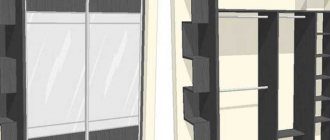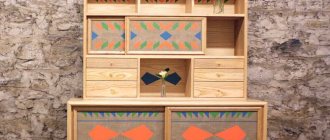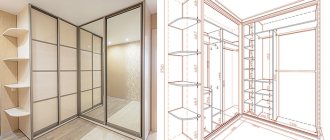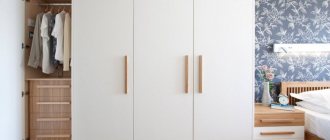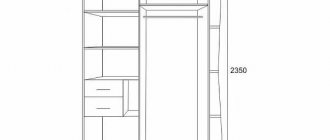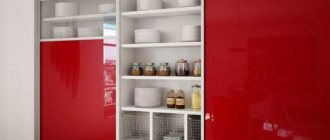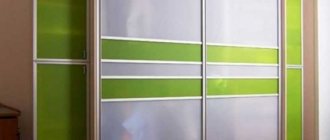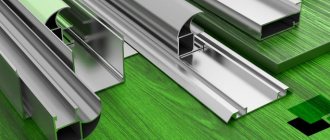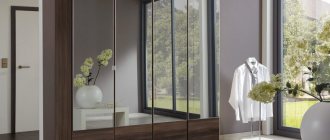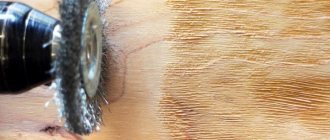Shapes of corner wardrobes: an overview of the features of each type
In order for a corner wardrobe to fit perfectly into the square footage of the room and be as convenient to use as possible, it is important to know what shape they come in.
Let's look at the main types of corner wardrobes:
L-shaped
It is a structure of 2 separate cabinets, which are located along the walls and connected at right angles, forming the letter “L”. These two bodies can be the same size or asymmetrical.
L-shaped corner wardrobes are the most compact type of this furniture, therefore they are optimal for small rooms.
Radial (radial)
The cabinets are distinguished by a facade that is shaped like part of a circle with the center in the corner.
A radius corner wardrobe can be with:
- Concave doors
, i.e. the radius “goes” inward, so the space in the room is not cluttered. This design is perfect for arranging deep niches.
- A convex façade
is a radial surface outward, which looks original, but at the same time occupies part of the usable area of the room.
- Combined doors
- combines concave and convex facades. The design of the combined wardrobes resembles a wave and looks truly amazing in the interior.
There are also semicircular corner wardrobes. They act as a mini-wardrobe and are traditionally installed in very small spaces.
The main features of radius corner wardrobes are their original design and the absence of sharp corners. Because of this, they are advised to be placed in rooms where the decoration lacks smooth lines, as well as in children’s rooms.
Trapezoidal
As is clear from the name, this type of corner wardrobe resembles a trapezoid, which can be ordered in various shapes (isosceles, rectangular).
It is important to say that in a trapezoidal design the number of doors is less than, for example, in L-shaped models. Moreover, the occupied area increases and the capacity decreases. But at the same time the price decreases, which makes them more financially accessible.
5-wall (pentagonal)
The shape of this design resembles a pentagon (usually equilateral). The 5-wall model is similar to the trapezoidal one, but unlike it, it has an additional side wall.
Of all the types of corner wardrobes presented, this is the most massive, but at the same time the deepest and most convenient to use. Therefore, this option is very popular among users.
Such a large corner wardrobe is traditionally placed in the bedroom, as it can accommodate everything: from personal belongings to bedding and equipment.
Diagonal (triangular)
When viewed from above, this corner wardrobe has the shape of a triangle. It harmonizes perfectly with the other furnishings of the room, is able to accommodate a large number of things, but at the same time “takes up” space. Therefore, it should not be installed in rooms with “modest” dimensions.
The main advantages: simplicity of design and low cost.
Before you order a corner wardrobe, look at the photos of the options to know exactly how it looks in the interior.
Varieties
According to the manufacturing method, a corner cabinet can be:
- hull;
- built-in;
- modular.
L-shaped cabinet models are sold ready-made or made to order according to the required dimensions. A mini cabinet is a full-fledged piece of furniture with a top and bottom surface and side walls. A cabinet is often delivered disassembled from a furniture workshop; craftsmen assemble it in the apartment. Mobile furniture can be easily rearranged from place to place or taken with you when moving.
The cabinet built into a special recess has the largest capacity compared to a similar cabinet model. Properly installed furniture will fill an architectural niche and adjust a room with complex geometry. The absence of walls can significantly reduce the cost of furniture, and decoratively decorated doors will help create a stylish, original interior.
The monolithic structure occupies the entire space from floor to ceiling and, as a rule, is made to order, taking into account all the customer’s preferences. But it should be borne in mind that stationary furniture is difficult to dismantle, so it can only be used in one specific place. To avoid the appearance of unpleasant odors, built-in furniture must be ventilated periodically.
A modular corner wardrobe will fit perfectly into a small room. It can be used to arrange rooms with complex configurations. The universal model can be arranged at your discretion, creating convenient combinations. An asymmetrical cabinet consisting of floor-mounted and wall-mounted modules looks especially interesting in the interior of a small room. An original design solution will add novelty and completely transform the space.
Built-in
Modular
Hull
Choosing the material for making the body of the corner wardrobe
The most considered materials for making the body of a corner wardrobe are:
- laminated chipboard
. The material is distinguished by: a wide variety of colors; durability (lasts 10 years or more); excellent protection against mechanical influences, good moisture and heat resistance. Corner wardrobes made of laminated chipboard are durable, reliable, beautiful and inexpensive, therefore they are the most popular on the market. The only negative is the fragility of the slab, which increases the chance of chipping.
- MDF
– raw materials that are safe for human health and have a longer service life than laminated chipboard (min. 12 years). Corner wardrobes made of MDF are not afraid of moisture, scratches and high temperatures. You can make furniture of any design and color from this material by painting it with glossy/matte paint or covering it with a protective PVC film.
- Natural wood
– the most expensive raw material for the manufacture of corner wardrobes. The high cost is explained by the fact that wooden furniture lasts for centuries, looks royally luxurious, is 100% harmless, is highly durable and can be restored/repaired. The only disadvantage is the fear of moisture in wood.
Fronts of corner wardrobes: which ones can be ordered
The facade of the corner wardrobe is its “face”. If the filling of the structure and the body are hidden “from prying eyes,” then the design of the doors is open to everyone and directly affects the overall interior of the room.
In order not to get lost in the huge assortment of corner wardrobe facades, we suggest putting everything “on the shelves”.
So, what doors can you order:
Mirror
A corner wardrobe with a mirror, reflecting the room, visually makes it larger and lighter, which is very important for rooms with a small square footage.
You can choose a regular mirrored corner wardrobe or:
- decorated with sandblasting or photo printing;
- decorated with an acrylic pattern or artistic matting;
- decorated with stained glass with bevels, laser engraving or crystals.
When purchasing a custom-made corner wardrobe, you can choose any design as decoration, as well as photo printing using personal photographs.
It will be useful to know:
“Care for glass with a sandblasted pattern”
Glass
Just like a corner wardrobe with mirrored doors, transparent / frosted glass facades can be covered with:
- photo printing;
- special varnish;
- exquisite design;
- colored or plain film.
Corner wardrobes with frosted glass, decorated with a beautiful sandblasted pattern, and Lacobel glass (when one side is covered with an even layer of varnish/paint) look especially charming.
Material on the topic:
“Technology of photo printing on glass”
Blind ones made of chipboard or MDF
One of the most affordable and time-tested options are facades made of MDF / chipboard. These slabs can be chosen in almost any color and design (for example, imitating wood or antique-style). With such an assortment, everyone can find a model to suit their taste and interior style.
If you compare chipboard and MDF, then it is recommended to give preference to the latter. Because MFD has a more even, smooth surface, is easy to process, tolerates moisture better and is safer for humans. But chipboard is cheaper. The choice is yours.
Natural rattan or bamboo
Such fronts of corner wardrobes will be appreciated by fans of natural materials and such style trends as: country, eco-style, colonial.
Simple natural weaving on the doors gives the furniture nobility and solidity, creating a comfortable and warm atmosphere in the room. In addition, rattan and bamboo are durable materials that do not absorb moisture, are resistant to abrasion, do not deform and do not fade in the sun.
Leather/fur
The idea of decorating the facades of corner wardrobes with leather and fur arose relatively recently and immediately found fans among lovers of exotic designs.
Such materials are pleasant to the touch, come in a variety of colors and look very impressive. With proper care, this finish will delight its owners for decades, while maintaining its original appearance.
Leather and fur facades go well with other materials: glass, mirror, rattan, etc.
Plastic
For those who are looking for a practical, durable, easy-to-maintain and inexpensive facade, pay attention to plastic, also known as “acrylic glass”.
The material bends well, does not harm health, is easy to clean from dirt and is not afraid of scratches. Moreover, breaking a plastic panel, despite its light weight, is much more difficult than a mirror and glass. Therefore, it is recommended to install corner wardrobes with plastic doors in children's rooms.
Article on the topic:
“How to choose the right children’s furniture: everything you need to know”
We have offered 9 ideas for the fronts of corner wardrobes with photos, of which everyone will certainly find an option to their liking and wallet.
Material of manufacture
The reliability and practicality of cabinet furniture and its service life depend on the quality of the material. For the production of standard models the following are most often used:
- MDF - surfaces are covered with veneer from various types of wood. The facade turns out to be strict and laconic. Modern coating is environmentally friendly and does not emit harmful substances into the atmosphere;
- LDSP - chipboard has excellent decorative qualities. The material is easy to maintain and can withstand negative mechanical influences. The impressive glossy finish is particularly durable and wear-resistant;
- natural solid wood - corner cabinets made of wood look expensive and respectable. In the photo you can see exclusive models decorated with carvings and various decorative elements. Luxurious furniture will decorate any classic interior;
- plastic - plastic cannot be classified as a traditional material for the production of mini cabinets. But at the same time, the technical characteristics of the material make it possible to create original models that can decorate a modern nursery hallway or bedroom.
Manufacturers pay special attention to the design of doors. Mirror surfaces are the most in demand. An original floral, floral or geometric pattern is applied to the glass surface. Bright stained glass elements look unusual; colored glass creates light reflections in the room and a fabulous atmosphere of celebration and good mood.
Wood
Mirror
Chipboard
MDF
Options for filling corner wardrobes
The main task is to accommodate as much as possible and occupy as much space as possible. Therefore, the internal content of the corner wardrobe should be thought out in detail and depending on where it will be installed (in the bedroom or hallway).
What I recommend including in furniture:
- Drawers
are necessary for storing underwear, socks, handkerchiefs and other small items. It is advisable to equip them with closers so that they do not rattle when closing.
- Shelves
- the more, the better, because... It is on them that you can place the maximum number of things. We advise you to order a corner wardrobe according to your size - this way you will get shelves of different heights for storing things of different sizes. For example, bed linen and pillows need a higher shelf, and T-shirts need a lower shelf.
- The barbell
is a necessary and convenient attribute. Here, on hangers, ironed seasonal clothes or holiday outfits in covers are placed.
Additionally, you can equip the corner wardrobe with hooks, roll-out shelves, pantographs (pull-out hangers), tripods, baskets and containers.
Find out also: “Why do you need a dressing room”
Advantages and disadvantages
Personal items, seasonal clothes or shoes are usually stored in the hallway or bedroom. Corner placement of cabinet furniture has many advantages:
- stylish design - a small cabinet is often the main component of a modular group; its design will organically fit into any modern interior;
- compactness - a convenient swing opening system will save free space near the cabinet;
- spaciousness - a modern internal storage system allows you to place a large number of personal items;
- functionality - the choice of L-shaped structures will help to visually adjust the space, make it a little wider and more spacious.
Some minor disadvantages of cabinet furniture include:
- height of the structure - the upper compartments are located at a difficult distance - this makes their daily use difficult. Seasonal items are often stored on mezzanines;
- opening system - in a narrow hallway, solid hinged doors block the free passage; in this case, give preference to a compartment-type hinged system;
- material - all family members pass through the hallway, so special attention must be paid to the quality of the material, otherwise the furniture will quickly lose its original appearance.
To decorate a small hallway, designers advise choosing a model with a light-colored facade surface. The most popular textures are various types of wood: alder, birch, beech, pine.
Types and sizes of corner wardrobes: what you need to know
The first simple piece of advice is to order furniture right up to the ceiling. This will allow you to “load” it with a lot of things. The remaining dimensions of the corner wardrobe must be calculated based on the area of the hallway, bedroom and other room.
But there are some general recommendations:
- For spacious and well-shaped apartments, it is recommended to choose triangular structures with an optimal side length of 120 cm and a depth of 0.4-0.6 m. In deep furniture, a regular rod is installed, in small corner wardrobes - parallel to the door.
- In rooms with several doors and windows, it is better to install diagonal models. Recommended dimensions: depth 50-70 cm; width 0.7-2.4 m; height 1.7-2.5 m.
- The trapezoidal corner wardrobe is ideal for the kitchen, nursery and living room. The standard dimensions of one wall are 120 cm and the second 80 cm.
- Radius models, as a rule, have a width of 120-210 cm and a depth of 0.85-1 m. Such furniture fits well into any room, except narrow ones.
For narrow or irregularly shaped rooms, it is better to order non-standard corner wardrobes made to individual sizes. To make the furniture comfortable and functional, it is recommended to make: a cabinet depth of at least 35 cm and a maximum of 90 cm; the width of the structure is from 1 m, the height is up to 4 m (otherwise it will be difficult to get things from the top shelves and simply open the doors).
Advantages and disadvantages
The main feature of built-in corner wardrobes is that they are made mainly to individual orders, with the exception of furniture intended for standard apartments, but there are few standard models in stores. The corner design has its advantages:
- furniture can fit organically into a small room where it would be very difficult to place another item;
- made according to an individually created design, looks unusual and original;
- The corner built-in wardrobe is universal - suitable for a room of any size and shape;
- the space where the cabinet is located (especially corners, niches) is used efficiently, rationally, economically; doors that do not swing open, but slide apart, do not require additional space;
- they look very aesthetically pleasing, especially the now fashionable radius cabinets due to their non-standard shape (concave, convex, wavy);
- successfully hides design flaws and uneven corners of the room;
- Having relatively small dimensions, corner built-in furniture has a large internal space.
In addition to a lot of positive qualities, such furniture has a number of disadvantages:
- complex shape - when individually manufactured, it requires additional money and time;
- low reliability of the sliding system (as with all sliding wardrobes with sliding doors), additional loads contribute to rapid wear of the roller guides;
- Built-in furniture is difficult to install and cannot be moved or moved.
Sliding door mechanisms: what to choose: steel or aluminum
The profile for sliding wardrobes is made of steel or aluminum.
Let's go through the main parameters:
- Service life
: the steel profile is designed for regular use for ≈8 years, the aluminum profile will last several times longer.
- Price:
aluminum system is 20-30% more expensive than steel.
- Strength:
aluminum can withstand doors with a thickness of 1.5 mm and a width of ≈120 cm (even with a mirror and a height of 3 m); steel is approximately 2 times thinner, so it cannot bear such loads.
- Resistance:
aluminum is not susceptible to corrosion, resistant to moisture and temperature changes; steel (subject to poor quality processing) can rust.
Doors move more smoothly and easily on an aluminum bottom track. The advantage of an aluminum profile is obvious. It's up to you to decide whether it's worth paying more.
Method of installing doors in corner wardrobes
According to the principle of door installation, there are:
- Built-in corner wardrobes
– do not have a lid, bottom and walls (back, side). Door guides are attached directly to the ceiling, floor and walls of the room. The cost of such structures is lower due to reduced material consumption and manufacturing costs. Built-in corner wardrobes look stylish in any interior, even suitable for rooms with multi-level ceilings. If the style of the room changes, it is enough to replace the doors without affecting the internal content. Minus - the floor and ceiling must be perfectly flat for installation.
- Supporting structures (hulls)
. An ordinary cabinet with walls, a bottom and a lid, where the guides are fixed to the lower and upper belts. Compared to built-in corner wardrobes, the price of these models is higher, but at the same time they are easier to install and do not depend on the evenness of the ceiling and floor. If we compare the capacity, it is less in the reference models.
We advise you to study: “Installation and dismantling of furniture: preference for professionals”
It is impossible to say which corner wardrobe to order for the living room, bedroom, or hallway - built-in or cabinet-mounted. It all depends on personal preferences, financial capabilities and the characteristics of the premises.
What to look for when choosing a corner wardrobe for the living room
To purchase a cabinet that is optimally suited for the living room, you need to take into account the following criteria: ceiling height, room dimensions, personal wishes for the design and design of the interior furniture, intended installation location, design features and spaciousness. The types of cabinets are triangular, built-in, trapezoidal, rectangular, five-walled, etc. The latter type refers to large corner wardrobes in the living room, which can be installed in a small room: the model is distinguished by good spaciousness and convenience, without looking massive .
When planning to order a cabinet, you need to remember that the complexity of manufacturing such furniture depends on the timing of its production. The cost of a corner structure based on an individual project is higher than that of standard factory samples, but the difference is compensated by quality and ease of use.
When examining a cabinet you like, you need to pay attention to its back wall. It must match the color of the entire structure and be laminated. The same applies to removable shelves. If a mirror is included in the package, it must be covered with a safety film.
When thinking through the internal layout of the cabinet, it is necessary to take into account the location, number and sizes of shelves and drawers, and rods. The presence of pull-out baskets for shoes and clothes makes the furniture more practical. Typically, the depth of the shelves is no more than 70 cm, the height is no less than 35 cm. Drawers that roll out completely are more convenient to use than those that roll out halfway. The design can also be supplemented with holders for an iron and a vacuum cleaner.
The sliding system, an important component of a corner wardrobe, can be made of steel or aluminum.
Advantages of aluminum profile:
- no noise when opening/closing;
- neat appearance;
- facade decor is presented in a large number of options.
Disadvantages include a short service life and high cost.
Advantages of steel profile:
- durability;
- reliability;
- low price.
The disadvantages include noise and limited finishing options, since steel is combined with a limited number of materials.
How to choose the right and beautiful corner wardrobe: 5 tips
When ordering this furniture, please note:
- The design of the corner wardrobe should match the overall style and color scheme of the room's interior.
- Blind doors and those decorated with large geometric patterns visually narrow the room, so for small rooms it is better to order corner wardrobes with a mirrored facade.
- If the room has a suspended ceiling, you need to leave a gap between the ceiling and the cabinet lid - min 5 cm.
- Doors wider than 1 meter are difficult to open, so it is better to make more narrow doors.
- If the furniture is intended for the bedroom, it is recommended to leave a passage between the bed and the closet of 60 cm or more.
Final advice:
equip the structure with lighting, so it will look more impressive and original.
Material to help:
“How to illuminate a wardrobe?”
If you have any doubts about which corner wardrobe to order, how to correctly calculate the dimensions and which style is best to choose, call . Our consultants will answer all your questions so that you can choose an option that is impeccable in terms of beauty and parameters.
